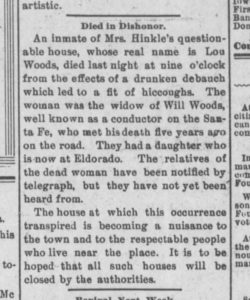by Kristine Schmucker, HCHM Curator
Throughout the 1890s the lives of women on the edge of Newton society were frequently the subject of newspaper stories. The tales were often tragic.
Mrs. Hinkle’s Questionable House
The March 16, 1893 edition of the Newton Daily Republican noted the death of a woman living in a house on the north east edge of the community.
“An inmate of Mrs Hinkle’s questionable house, whose real name is Lou Woods, died last night . . . from the effects of a drunken debauch which led to a fit of hiccoughs.” (Newton Daily Republican, 16 March 1893)
A sad end to a story that started roughly three years previous.
Favorably Known Railroad Conductor
On April 12, 1890, in El Dorado, Ks, William H. Wood died, the cause identified as “rheumatism.” Wood was a “favorably known railroad conductor.” He was a member of St Matthew’s Episcopal church in Newton where his funeral was held. Wood was a charter member of Newton Division No. 11 of the Order of Railroad Conductors, and a member of the Kingman Lodge, Knights of Pythais.
He began his career with the railroad on the I & St. L Railway. In 1878, he came to Newton and was employed with the Santa Fe until 1885. For a time, he worked a passenger run on the Wichita & Western between Wichita and Kingman. The last six months of his life, he worked for the Missouri Pacific at El Dorado. His obituary noted that he was survived by his mother and a wife.
Died in Dishonor
In 1893, the headline read: “Died in Dishonor” and the brief notice mentioned the death of Lou Woods, wife of Will Woods, while living at “Mrs. Hinkle’s questionable house.”
In 1895, Mabel Wood is identified as the sole child of William H Wood and Lou Wood in a legal matter involving lots 2, 4,& 6 in Block 37 in the city of Newton.
Although both William and Lou are buried at Greenwood Cemetery, Newton, neither have a marker.
At the conclusion of the notice of Lou’s death, the newspaper reporter observed;
“The house at which this occurrence transpired is becoming a nuisance to the town.”
The Bagnio of Mrs. Hinkle: A Nuisance to the Town
The first mention of the “bagnio of Mrs. Hinkle” is in the spring of 1891 when it was reported that
“A woman went to Carpenter’s livery . . . and procured a rig for the ostensible purpose of taking her mother . . . to her home in the country. Instead . . . she picked up Harry Emerson, Billy Moore and Jim Unknown and together they went to the bagnio of the Mrs. Hinkle.”
It seems the tragedy of Lou Wood was not the first brush with death at Mrs Hinkle’s.
“Maud, an inmate of Mrs. Hinkle’s house of ill fame, took an overdose of morphine which came near killing her last night. She took the morphine to relieve pain, swallowing 2 1/2 grains of it on top of a quantity of whisky.” (Newton Daily Republican 7 September 1892)
“A Notorious House Burned“
In early September 1893, the place was raided by officials who confiscated “beer and other refreshments.”
In September 1893, the “notorious Hinkle house” located on 12th street just outside of city limits burned to the ground in an overnight fire.
“A frame building in Northeast part of town, which has been used for several years as a bawdy house, caught fire last night and burned to the ground.” (Newton Daily Republican, 15 Sept. 1893)
Although some “curious men and boys were soon on the ground and succeeded in saving some of the furniture . . . most was destroyed.” The paper noted that the property was owned by a Topeka company and “has for a number of years borne a bad reputation.” The origin of the fire was unknown. No word on what happened to Mrs. Hinkle or any other inhabitants.
Notes
- Despite being an unattended death, Lou Wood’s body was not seen by the coroner.
Sources:
- Newton Daily Republican: 14 April 1890, 12 March 1891, 14 March 1891, 22 April 1891, 7 September 1892, 14 March 1893, 16 March 1893, 19 April 1893, 20 April 1893, 8 September 1893, 15 September 1893, 10 December 1895,
- Weekly Republican, 29 March 1895.
- U.S. Census, 1860, 1870.
- Greenwood Cemetery Index



